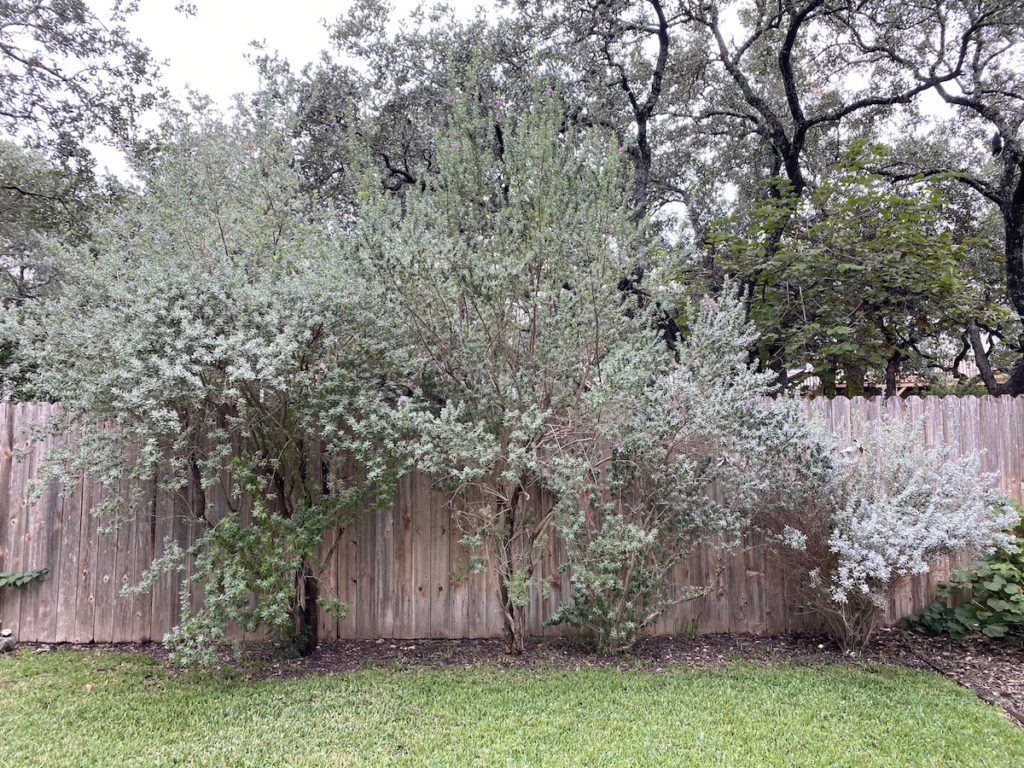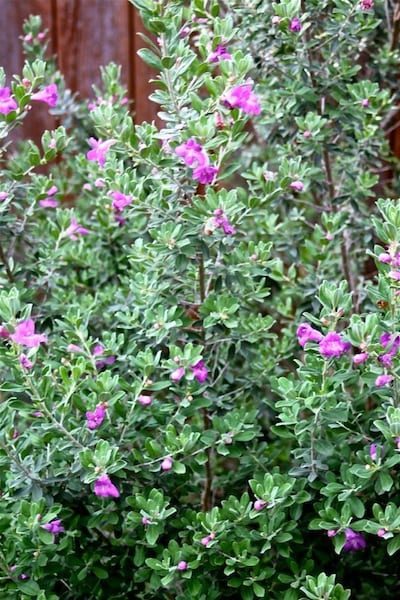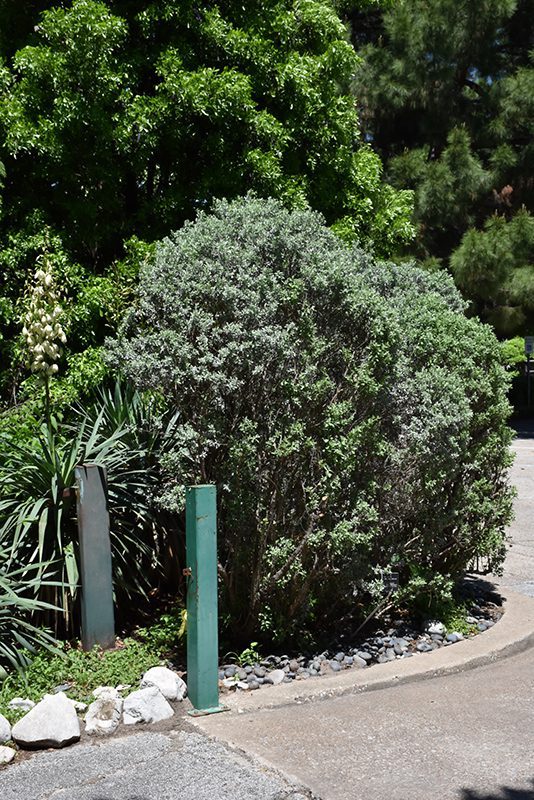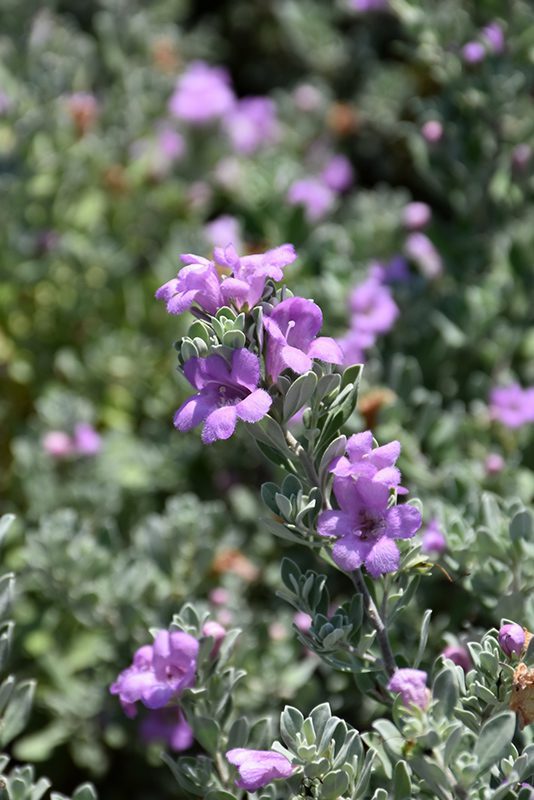It’s tree and shrub planting season, y’all! Fall is the best time to plant, replace, and transplant shrubs in your landscape. Texas Sage (Leucophyllum frutescens), also called Cenizo, just happens to be one of my favorites, so today I’m highlighting some of the different varieties this native shrub comes in.
I remember, before I knew anything about the nursery business, I bought four Texas Sage shrubs to add to my landscape. I purchased one, than found the other three at later dates. Little did I know, nor did I do any research, that I had actually bought at least three different varieties. Nope, I didn’t pay attention to labels back then. Fast forward through the year and I found myself with four Texas Sage shrubs with various heights, and foliage and bloom color! (See pic below.)
Let my rookie mistake be a reminder to you to do due diligence and research each and every plant that you purchase. One plant name can hold many varieties, and this is common among a great number of plants at the nursery. Take a look at a few of my favorite varieties and their characteristics below, followed by basic care of all Texas Sage shrubs. I hope you’ll find the perfect one for your landscape this fall.


(Don’t judge! We all make rookie mistakes! To the untrained eye, Texas Sage can look the same during their small transplant stage. Research your plants!)
5 Texas Sage (Cenizo) Options for San Antonio Landscapes
- Silverado Texas Sage (Cenizo)
- Green Cloud Texas Sage (Cenizo)
- Lynn’s Legacy Texas Sage (Cenizo)
- Compact Texas Sage (Cenizo)
- Desparado Texas Sage (Cenizo)
1. Silverado: The silver-gray foliage on Silverado Texas Sage is evergreen with pink-magenta flowers that appear in abundance summer through fall, especially a week or two before rain is on the way (more about that later). Silverado grows about 4′ tall x wide, and is a great option to use for a hedge choice.
2. Green Cloud: The foliage of Green Cloud matches its name. Green foliage is peppered by rose-magenta blooms throughout the year. This variety actually tends to put out more blooms than some other varieties. Green Cloud grows about 6′ tall x wide. Plant in full sun, well-draining soil.
3. Lynn’s Legacy: This happens to be one of my absolute favorite Texas Sage varieties, although it can sometimes be hard to find. When Lynn’s Legacy is in bloom, the onlything I can say is, WOW! The lavender blooms are incredibly profuse and more prevalent than some of the other varieties throughout the year. Green foliage is dense, and grows in a uniform shape, reaching 5′ tall x wide. You can plant this one right next to the reflected heat of sidewalks and driveways and it doesn’t mind at all.
4. Compact: One of the smaller versions of Texas Sage, the compact variety grows only 3′ tall x wide, making it a great options for foreground shrubs, or even containers. Silver-gray foliage gets adorned with lavender-magenta blossoms spring through fall.
5. Desperado: Shimmering, silvery-green foliage and lavender blooms are prevalent on Desperado Texas Sage. The 5′ tall x 5′ wide stature of Desperado allows for you to use this shrub as a stand alone specimen or incorporate it into other beds or mass plantings. Desperado has silvery-gray foliage with lavender-pinkish-purple blooms that generally appear summer through fall.
These three pics below feature from left to right: Green Cloud, Compact, Desperado. These are just to show you the different variations in foliage and even bloom color. Read your labels; research your plants!






Care for Texas Sage (Cenizo)
The general care for Texas Sage is:
- Plant in full sun to partial sun. 8 hours minimum of full sun is preferred or it can grow leggy.
- Plant in well-draining soil (tolerant of poor soils, but not soils that don’t drain well.)
- Water to establish, but once established, Texas Sage is very drought tolerant. In extreme periods fo heat and drought they may need supplemental irrigation.
Texas Sage are evergreen, native, deer-resistant, pollinator-friendly, drought and heat tolerant shrubs that are excellent choices for our climate here in San Antonio. They are cold tolerant to 5° (and mine survived SNOVID). In 2005 Texas Sage was named the official Texas Native Shrub of Texas. They have also been nicknamed the “barometer” shrub as their blooms are initiated by high humidity in the air or excessive soil moisture in the soil either before or after rains.
The five varieties of Texas Sage that I listed are still just a few of the options you can choose from. There is even one called White Cloud that, you guessed it, blooms white flowers! I highly encourage you to consider these shrubs if you are looking to add to your landscape. They are low maintenance, water-savers and I think you will love them!
~The Happy Gardener, Lisa Mulroy


Love my sage! Thanks for the info!
Hi Bruce!
Me too! Such a great option for Texas landscapes! Thanks for reading.
How can I send you a picture of monarch caterpillars on milkweed
Bruce,
You can email me at lisa.rainbowgardensbiz@gmail.com and upload your pic. Please also let me know if you offer me permission to use it at some point, with credit to you of course. Thank you for wanting to share! Cheers!
Are they dangerous to animals?
Hi Dennis, I am not sure which animals you are inquiring about, but as far as we’ve seen the plant does not appear on plant toxicity databases, but always be aware that individual animals can react differently, or have intestinal issues when nibbling any plants. I would look up a couple of plant toxicity databases and double check, but I don’t think there is a real cause for alarm.
Why is my Texas sage turning yellow?
Hi Jeri,
We’ve had a period of wet weather lately. That, combined with cooler weather, is most likely the culprit for the yellowing of leaves on your Texas sage. The problem should subside once the soil is able to dry out a little more. Texas sage should always be planted in an area where the soil drains extremely well. If you made sure of that, just give it a little time for the soil to dry up some.
Is Texas Sage (Cenizo) safe for dogs?
Hi Bob!
While this particular type of sage is not on the toxic list from the ASPCA, you should always make sure you ask your vet about any plants you are questioning. Some dogs can eat even non-toxic plants and get sick, so I’m thinking your vet may have more insight on your particular breed. Here is the ASPCA link for toxic plants, it’s a good resource tool!
I’m not sure if what I have planted is Lynn’s Legacy or Green Cloud. How can I tell the difference?
It hasn’t stopped blooming since spring. Absolutely beautiful!
It’s really hard to tell the different varieties sometimes. Green Cloud grows to an average of 6-8 feet and has a larger leaf and lush green foliage, while Lynn’s Legacy grows to about 5 feet and has a smaller leaf with sage green foliage. But unless they were next to each other to compare, it might be difficult to tell. I’m attaching a pdf on different sages and you can look at the green cloud to see if the foliage matches what you have.
I will say that Lynn’s Legacy is a real stunner when in bloom, so it’s possible you have that one.
Does the sage have any issues with pests such as worms or aphids?
Thank you for details about each variety – I am looking to make some landscaping changes this fall after the drought and want to incorporate more natives. I know there are differences in cerizo and your descriptions are helpful.
Hi Jennifer,
Wonderful to hear you are interested in including more natives to your landscape. We have some good info on our website about some our favorites, and more info to come in the next 2 months. (Just search native or natives on rainbowgardens.biz) Thanks for reading; well and successful wishes for your new landscape design!
Hello, I live in Arizona and had planted Leland evergreens to create a barrier between the neighbors. Well, all four died from the heat and over use of nitrogen bush sticks. 😥 lesson! learned. Anyway, I’m interested in Texas sage and I found Lines ever looming at home depot. I like the green but really the magenta flowers. Can they grow higher than 5′? Like I said I want to create a wall for boundary and protect cars in the carport.
Hi Dennis,
In general 5-8 feet is the max for Texas Sage, but sometimes they can get a little taller depending on care/pruning. Green Cloud has the green foliage and magenta flowers and gets a little taller at 6′ Tall x wide. ‘Heavenly Cloud” might be an option for you, as it grows 6-8 feet tall and grows a little more narrow than Green Cloud. Make sure you have enough space for whichever you choose. Pruning to get Texas Sage to fit in your space will eventually limit the amount of blooms. Just carefully research the varieties available to you in Arizona, and don’t purchase any that are not labeled specifically, as there are quite a few varieties to choose from and many look exactly the same when small.
You might also want to take a look at our some of our favorite privacy hedge plants here. Just make sure they are suitable for your area in Arizona.
Good say.
Do these plants really have “stinging caterpillars that have stiff poisonous hairs or spines on their bodies that are connected to poison glands” Im in the US Virgin Islands and bought one before googling it.
HI Yvonne,
There are different types of moths whose caterpillar larvae may sting or have poisonous traits, but I am not aware that any of these particularly seek out the Texas Sage.
Hello! I just planted a few green cloud Texas sage shrubs in my front landscape bed. I bought them particularly because it was my understanding they are easy to care for- I’m a novice. How often should I water them when planted new? And how long does it take for them to be established to the point where watering is hardly needed? I’m not sure if I’m over or under watering. What are the signs of each? They don’t seem to be doing great so far 😔. Thanks for any guidance!
Hi Emily,
If you live here in San Antonio, you probably need to be watering your Texas Sage every 5 days for awhile, until we get through this drought, and until the temperature gets cooler and we receive some rain. You don’t want to overwater, but since it has been so dry and so hot, it’s a little harder to get plants started, so extra water may be needed. It can take a full 2 years for your shrub to be completely established. The big thing is to make sure your soil drains well so water isn’t standing around for too long around the roots. It’s weird, but the signs are similar with overwatering and underwatering. Leaves turn yellow, brown (black with severe overwatering, which I doubt you are doing), and drooping or wilting. Make sure when you water you are watering slowly and deeply (1″-2″ of water). If you still see those signs, double check that your soil is draining well.
Thanks so much for the info! A neighbor suggested using a vitamin B additive to help new plants- is this something you recommend? If so, where can I buy it?
Generally Texas Sage won’t need that additive, but if you wanted to try it to boost the root system, it won’t hurt. SuperThrive is a good option for a product that contains vitamin B. We sell it at both of our locations. Follow the label for application directions.
This info is great! Just purchased a few Green Cloud shrubs to hopefully transplant from pots directly into the ground soon. They’re currently about 2 feet high. Should I transplant now, since it’s technically fall, or wait a few weeks for it to cool off? Also, how can I tell if my soil is “well-draining?” THANKS!
Hi Mindi,
Now that it is October, and I think the weather is cooling off enough, it’s ok to plant now. If you decide to wait a couple of weeks, just make sure your Green Cloud sage doesn’t dry out in the nursery pots before you plant. You can check for well-draining soil by doing this test where you plan on planting.
One of the best ways to determine a soils aeration, drainage and water holding capacity is to conduct a “hole
test.” Here are the basic steps:
1. Using a post-hole digger, sharp shooter or similar instrument, dig a hole 6” – 8” in diameter and 2’ deep.
2. Fill the hole approximately ½ full with water. Note the time.
3. Determine how long it takes for the water to drain from the hole
Use the following guidelines to interpret results from the hole test:
< 15 min = Excessive drainage. Consider adding organic matter to increase water holding capacity. (Won't need to add anything for for Texas sage) 15 – 30 min = Adequate drainage and water holding properties. Modifications not required, fine for Texas Sage. >30 min = Poor drainage. Consider raised beds or incorporating coarse textured materials to increase aeration
and drainage.
Hope this helps. Happy planting!
This is so helpful, thank you! I did the test, and the water drained in less than 5 minutes. It’s technically a retaining wall, so that was no surprise. My only concern is how many rocks I dug up along with the soil. I hope it’s not too rock-heavy for the sage to take root and spread!
I don’t think it will be a problem. Texas sage is used to our rocky, limestone soil.
Your article says plant Texas Sage in Fall, but can I plant in a south facing area, along a wire mesh fence, if O blanket with a freeze> Thank you for any advice?
Yes, you can still plant now. If a hard freeze is predicted, make sure it is watered in well the day before or the morning of and cover with freeze cloth, blanket, etc.. Once freeze passes and the sun comes out, uncover.
Potatoes can withstand a light frost (28°- 32°), but like anything newly planted in winter, it’s best to cover them with freeze cloth if a hard freeze is predicted. If they are protected with freeze cloth, or blankets, etc… they should be fine. January and February are the right months to plant seed potatoes in San Antonio, you just always need to have freeze protection ready as our weather is somewhat unpredictable.
Hi there,
l have been trying to find a supplier in the uk for this plant Lynn’s Legacy” but know luck yet we do sale the Silverado,
Are there any suppliers in the states that supply the seeds or plants that do mail order.
kind regards
Andrew Fuller
Can I plant Desperado Tx Sage 2-3 ft apart to create a solid hedge?
Hi Leslie,
The recommendation is generally planting about 4′- 4.5′ for a solid hedge with Desperado. The mature size is about 5′- 7′ tall x wide, so if you try to plant it 2′ apart, you are really squishing it in there.
I want to buy Texas Sage and would have to pot it since I have a rock yard. My question is.. would it be okay since it needs room to grow. What size pot?
Also, are they available in the Fall like October? I live in Hemet, CA and it stays hot thru Sept. I’m hesitant putting the pot in full sun- should I put it in partial sun until established in the pot?
Texas sage LOVES the heat. And does well in a pot as long as there are plenty of drainage holes. I would opt for at least an 18″ deep pot, and 5 gallon capacity at first because of the taproot. You can grow it in there for some time, and bump up to a larger size if it gets too rootbound. I do not know availability in California, but here in San Antonio, Texas, we do have them available in the fall. Fall is the best time to plant shrubs and trees in Texas. At this time we do not have the ability to ship plants.
If I buy renegde texas sage , Can i keep it to only 3-4feet high.
Hi Barbara, If you are not opposed to having to prune it, you could maintain it at 3-4 feet, but I would look at Compact sage or Silverado, which both top out no larger than 4′ tall. Is there something particular you like about Renegade sage over the smaller versions, especially since you like the height of the more compact sage?
Can I dig up and move Desperado sage am in mid FL, have 3, in partial shade, and they are leggy. It is late Feb. here now, and have a very sunny well draining area that nothing wants to grow in, ie., everything “fries”. This is sounding like perfect answer for my plants, and this bare spot of my yard! Any advice???
Hi Deborah,
I am not entirely sure on the timeframe recommended in Florida for uprooting and transplanting, as we are based out of San Antonio, Texas, but I believe the timeframe is similar to here, and unfortunately that would mean the window has passed for transplanting. Late fall/early winter is the ideal time to move a large plant like a shrub or tree. Reason being is that the shrub will go through a significant period of shock after transplanting, and the cooler temperatures of fall and winter allow for as minimal stress as possible for the roots to recover. I would worry that the shrub would have difficulty recovering enough time to survive the first summer in its new location.
That being said, I would suggest you contact a reputable local nursery in your area to make sure on the timeline. In a different situation if you were just looking for a good plant for that area, instead of digging up and moving it, yes, I believe the sage would be a great shrub for that area, and they are most likely leggy due to too much shade as you stated. Maybe get through one more year (you could plant some heat-loving annuals in the meantime in that area) and make plans to transplant next November?
Hi. Does a Texas sage tree have a tap root? The tree is about 4 feet. It is in a location that doesn’t get the amount of sun required. I really need to move it. I live in ft worth. Thank you so much for your help.
Hi there!
Yes, unfortunately Texas Sage does have a deep taproot. It’s difficult to successfully transplant one the size of yours. If it was much smaller you might get away with it. It’s also not the right time to transplant trees and shrubs, fall (Late October – early December) is a better time. Trees and shrubs will go into shock from the transplanting process, and will take awhile to recover. You don’t want them trying to recover with the summer heat heading in.
How much of the taproot can the tree survive with. All of it or half of it. I’m certainly not familiar with this and I may try to move it late fall. Thanks for helping me.
Oops….sorry this reply got lost in the shuffle…advice is to get as much as the taproot as possible (as much power as you can muster and as much will to extract as deep as you can). Then, prune it back by 50% after transplanting so that all the energy goes into rejuvenating that root. Water it in thoroughly right after replanting, and then don’t water again til the new growth starts to pop. Good luck, it’s not an easy task. But I’ll be eager to hear if you have success.
I’ve seen Lynn’s Legacy at local nurseries and the plant itself, when not in bloom, doesn’t seem as lush and attractive as other varieties of Texas Sage. Is this true once in the garden? I would like to plant two rows of three plants each in front of my house, and how they look when not in bloom is more important to me than how they appear in bloom.
Hi Alex,
I have seen Lynn’s Legacy look both ways; attractive and not attractive. I have to wonder if: when unattractive in the nursery pots it just needs to get out and stretch its legs, and when unattractive in a landscape it has to do more with care. It is one of the more slow growing varieties so that may be something to keep in mind. It should be left to as much of a natural shape as you can let it be, as over pruning could give you woody, and knobby-kneed growth. You also must be careful not to overwater it, and I believe many well intentioned gardeners do this to the detriment of the plant. In general, it grows in a mounded shape and the long bloom period is pretty spectacular, as it doesn’t depend so much on humidity for its blooms as other varieties do.
All this being said, you may want to also look at the Rio Bravo variety as it tends to have more even growth (meaning you will have foliage on the base as well as the top. (Many Texas sage have less balanced, top growth.) Especially since you don’t seem to be quite as concerned with the amount of blooms as foliage.